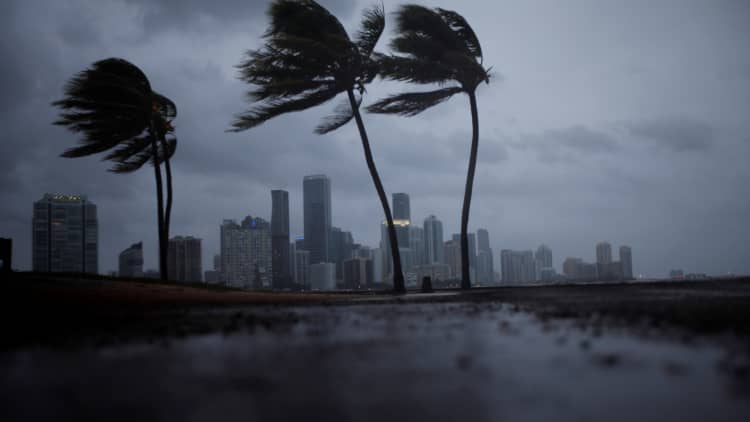
Hurricane Irma churned viciously up Florida's west coast on Sunday, aiming at Tampa-St. Petersburg after making landfall twice, swamping Florida's Keys and pummeling Miami.
The storm was downgraded to a Category 2 storm with 110 mph winds late Sunday afternoon, the National Hurricane Center said.
No deaths were reported, but the economic impact on the state was expected to mount. An estimated 127,000 people were in shelters around the state, and power was knocked out to more than 1 million customers across Florida, The Associated Press reported.
Thousands of flights on four continents have been grounded as well.
A Miami woman who went into labor was guided through delivery by phone when authorities couldn't reach her in high winds and street flooding, the AP reported. It said firefighters later took her to the hospital.
The second landfall came at Marco Island, south of Naples, around 4 p.m. ET Sunday afternoon. It had first made U.S. landfall at Cudjoe Key in the Florida Keys at 9:10 a.m Sunday.
A man who stayed in his Key Largo home told AP he saw small boats, furniture and refrigerators floating down the street. "Very noisy," John Huston said by text message to AP. "Shingles are coming off."
Both its movement over land throughout the night and its southwesterly wind shear will likely weaken the storm, forecasters said Sunday evening. Its expected course takes it inland over northern Florida into southwestern Georgia on Monday afternoon. It is expected to retain hurricane strength until at least Monday morning.
Before its first Florida landfall, Irma had weakened from Category 4 to 3 while over Cuba before churning back out to sea.
NOAA's GOES-16 satellite captured this image of the storm:
And the Air Force Reserves Hurricane Hunter planes caught this footage from above the storm:
Forecasters issued storm surge warnings for the Keys and for Tampa Bay on the state's west coast. Surge warnings also were in effect for the area from North Miami Beach southward around the Florida peninsula, as well as for the area between the South Santee River and Jupiter Inlet.
"A Storm Surge Warning means there is a danger of life-threatening inundation, from rising water moving inland from the coastline, during the next 36 hours in the indicated locations," the hurricane center said.
Tides more than 3 feet higher than normal were reported Sunday afternoon in Miami Beach, likely the result of storm surge.
The Tampa-St. Petersburg-Clearwater area, which is built around a huge bay that cuts into the mainland, has not taken a direct hit from a major hurricane in nearly a century.
Tampa Mayor Bob Buckhorn tweeted that the city is about to be "punched in the face" by the storm.
He added that the city was putting a 6 p.m curfew in place.
In preparation for the storm, officials issued dire warnings to Florida residents, with mandatory evacuation orders sending millions fleeing for safety.
Police officers in Miami Beach told surfers to leave beaches over the weekend.
On Friday, the National Weather Service warned via Twitter that "nowhere in the Florida Keys will be safe," and that residents should clear out while they were able.
"You need to leave — not tonight, not in an hour, right now," Scott warned residents in the evacuation zones Saturday.
FEMA's top official warned that people who chose to defy evacuation orders would be left to their own devices, with no immediate help.
"You're on your own until we can actually get in there, and it's safe for our teams to support local and state efforts," Brock Long told CNN. "The message has been clear — the Keys are going to be impacted, there is no safe area within the Keys, and you put your life in your own hands by not evacuating."
—CNBC's Marty Steinberg, Javier David and The Associated Press contributed to this report



